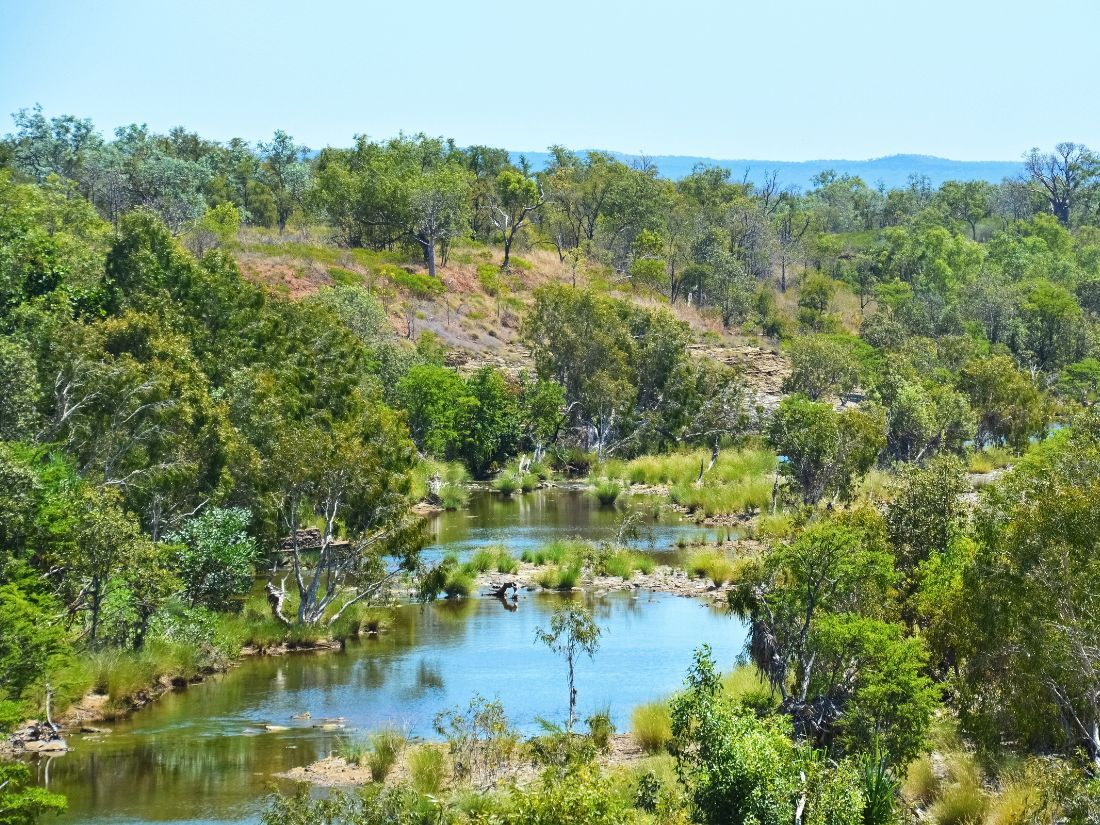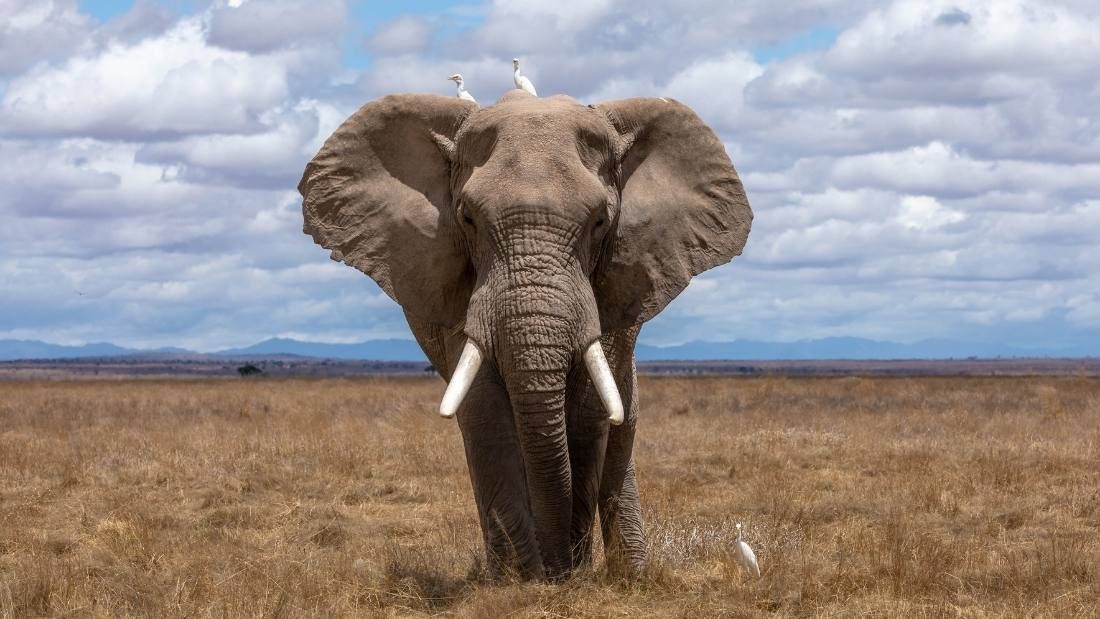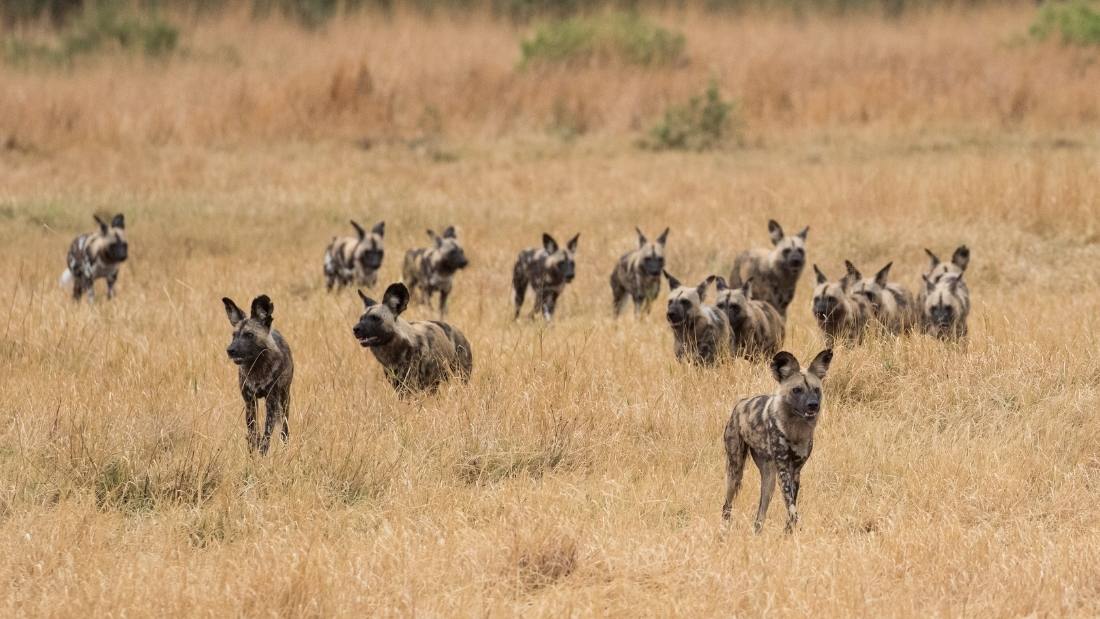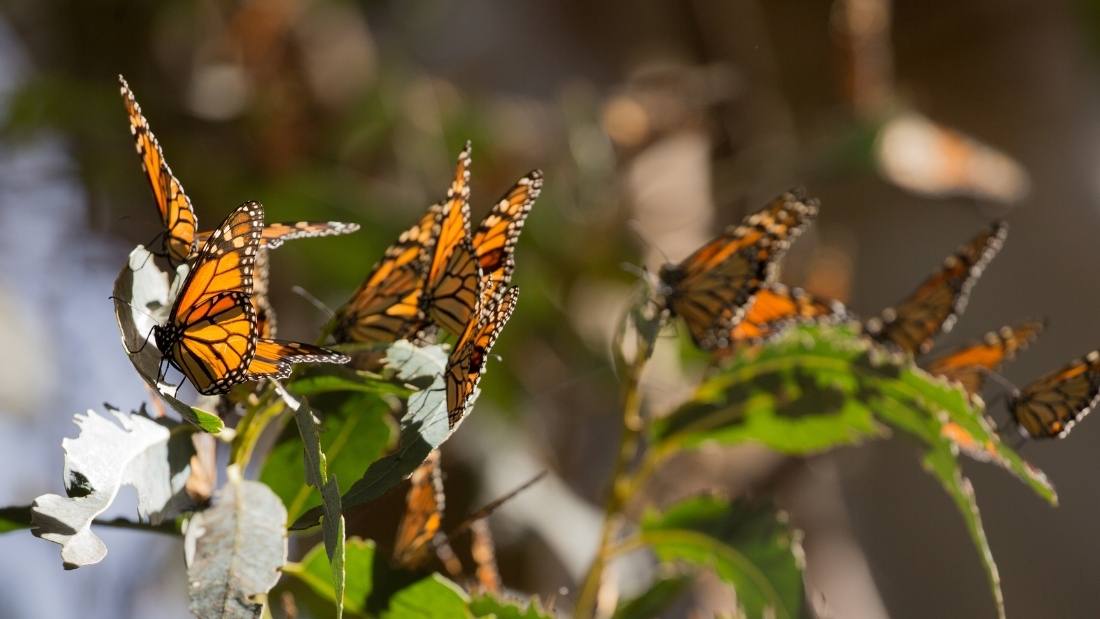Grassland Biomes in Crisis

Grasslands and savannahs are being destroyed for meat production and a typical example is the African savannah; home to a huge variety of mammals, reptiles, amphibians and birds.
Roaming elephants and buffalo, grasshoppers and beetles, ants and termites constitute an extraordinarily complex and diverse ecosystem that has evolved over thousands of years but which is now under threat, with many native animals becoming endangered.
From African elephants to Monarch butterflies along the Californian coasts – animal agriculture is destroying wildlife across the planet.
“Human impacts on the natural environment have reached such proportions that in addition to an ‘extinction crisis’, we now also face a broader ‘biome crisis’.”
(Hoekstra et al., 2005.)
There are two main types of grasslands; tropical and temperate. In all these regions grasses are the naturally prevailing vegetation. Collectively they are known as “grassland biomes”. The relentless expansion of agriculture has caused grassland biomes to steadily shrink, endangering native plants and animals.
Tropical grasslands
Tropical grasslands include the savannahs of sub-Saharan Africa and Australian rangelands.
Savannahs occupy a fifth of the Earth’s land surface and are characterised by the coexistence of trees and grasses. They are found where there is not enough rain to support a forest, but not so little that desert forms. It can be a delicate balance and they are among the ecosystems that are most sensitive to changes in land use and climate (Sankaran et al., 2005).
According to Dr Brett Murphy, of Charles Darwin University in Australia, grassland biomes are considered poor cousins of tropical rainforests. In areas of high rainfall, the diversity of vertebrates in grassland biomes can be just as high as in rainforests and Murphy argues that these biomes should be recognised as critical, but increasingly threatened, stores of global biodiversity (Murphy et al., 2016).
The African savannah is home to a wide variety of grazing animals, such as zebra, gazelles and wildebeest. They are preyed on by predators such as cheetahs, lions and leopards. You can also find jackals, hyenas and predatory birds there. Some animals, such as elephants and buffalo, move around the savannah throughout the year, searching for food and water.
Large numbers of insects, such as grasshoppers and beetles, live above ground feasting on vegetation. Below ground, you can find ants and termites. In fact, there are more species of termites in African savannahs than anywhere else in the world. They are one of the few animals which can break down cellulose from dead wood. Therefore, they play an integral role in reintroducing nutrients from decaying plants into the soil which helps to aerate it. They live in big colonies and many build large mounds that can be several metres high, contributing to a unique landscape. These mounds offer shelter to other animals such as scorpions, lizards, snakes, millipedes and beetles. Specialist termite feeders, such as the aardvark, consume huge numbers of termites in one sitting using their long sticky tongues to penetrate inside the termite mounds and fish out the termites. Other savannah animals that feed on termites include frogs, lizards, bats and many bird species. This diverse community of organisms interact in a complex but balanced ecosystem that has evolved over hundreds, if not thousands, of years.
Human interference and the destruction of natural habitats have resulted in many of the native animals of the African savannah becoming endangered.
Zebras
Grévy’s zebra is the largest living wild equid and the most threatened zebra, listed by the IUCN as endangered. They have tall, large ears and their stripes are narrow. More than 15,000 once lived in countries such as Kenya and Ethiopia. Now, there may be less than 2,000 individuals. According to the IUCN, population decline is due to habitat degradation and loss induced by extremely heavy grazing by livestock. Disease from contact with unvaccinated livestock and competition with other animals, especially over access to water and high-quality rangeland, has further added to their decline.

Zebras
Elephants
African savannah elephants are the largest species of elephant and are the biggest terrestrial animals on Earth. They have very large ears and their front legs are noticeably longer than their hind legs. Less than a hundred years ago, as many as 10 million wild elephants roamed the African continent. Decades of poaching, conflict and habitat loss have decimated populations and the number of individuals left in the wild is severely reduced.
In 2016, the Great Elephant Census, the first‐ever pan‐African survey of savannah elephants, estimated that there were only around 350,000 individuals across 18 countries. It confirmed massive declines finding that populations had fallen by 30 per cent (144,000 elephants) between 2007 and 2014 alone and continue to fall by eight per cent per year (Chase et al., 2016). In 2020, the IUCN listed them as endangered. Previously, African savannah and forest elephants were treated as a single species and listed as vulnerable. Although poaching them for ivory in the 1970s and 1980s reduced populations, the loss of grassland to agriculture has decreased numbers more recently. According to the IUCN: “Rapid land use change by humans is driving the direct loss and fragmentation of habitat for African Savannah Elephants and is an increasing threat to populations across their range” (IUCN, 2022).

African savannah elephant
African wild dogs
African wild dogs are the largest wild canine in Africa and are mostly found in arid and savannah regions. They are team-players and hunt in packs, preying on medium-sized ruminants such as gazelles and antelopes. When running, they can reach speeds of up to 40 miles per hour. They are very social animals and are known to share food, assist weak pack members and collectively care for pups, which are prioritised over dominant pack members for feeding. They were once found throughout the African continent but have now disappeared from most of their geographic range. The IUCN lists them as endangered and estimates that there are as few as 1,400 mature individuals left and that number is decreasing. They are threatened by habitat fragmentation, human persecution and disease outbreaks. Not only are they being displaced by agricultural expansion, but African wild dogs are often hunted and killed by farmers who fear for their livestock.
Savannahs can also be found in South America, Asia and Australia. The sparsely populated savannahs of northern Australia represent the largest intact savannah on Earth, with very little land-clearing having occurred. There is, however, an active push by the local government to develop northern Australia for large-scale agriculture (Murphy et al., 2016).
Changing land use is the most serious threat to biodiversity in grassland biomes, especially in areas where intensive agriculture is viable. Rates of clearing have been very high in recent decades, exceeding rates of tropical forest loss, yet have received little public attention. The Brazilian Cerrado – a hotspot of plant diversity – has been extensively cleared for agriculture, with more than half of it lost in the last 50 years. The grassland biomes of mainland Southeast Asia and India have also been extensively cleared over the last century (Murphy et al., 2016).

African wild dogs
Losing carbon storage
Like forests, grasslands take carbon out of the air and store it deep in the ground; the roots of deep-rooted perennial plants may grow as deep as 10 feet into the soil. Grasslands cover a greater area than tropical rainforests and are critically important to global carbon and energy cycles. They store about a third of the world’s land-based carbon. In the Great Plains of the US, for example, cropland expansion for animal feed is driving the release of carbon stores. It is estimated that ploughing up land for cropland expansion in the US, releases as much carbon dioxide into the air annually as 31 million cars (Spawn et al., 2019).
Temperate grasslands
Temperate grasslands are found in every continent except for Antarctica. They include the Eurasian steppe, Argentinian pampas, Australian downs, South African veld and the central North American plains and prairies.
Much of the grasslands in North America have been converted for animal feed crops or grazing. Between 2008 and 2016, croplands in the US expanded at a rate of over one million acres per year (Lark et al., 2020). This loss of grasslands to agriculture has unknown long-term consequences but has already affected many species, including monarch butterflies – key indicators of insect biodiversity.
Western monarch butterflies
Monarch butterflies
Between four and 10 million monarch butterflies once inhabited the California coasts before dropping to just over one million at the end of the 1990s. In the years that followed, the population levelled off at around 200,000, but in 2017, numbers crashed to fewer than 30,000 (Canon, 2021).
What drove their drastic decline is clear; their natural habitats in grasslands across the US are being destroyed. Commercial agriculture is eating away their range. Genetically modified corn and soya, the vast majority of which is used for animal feed, is engineered to be resistant to herbicides. This has led to the widespread destruction of milkweed (among other plants), the only plant that the Monarch butterfly larvae eat. Of course, monarchs are also susceptible to climate change. That’s partly why they are considered a so-called “indicator species” revealing the devastating toll taken on other insects and ecosystems (Canon, 2021).
This annihilation of wildlife comes with an ever-decreasing return in terms of food security. A study in the journal Nature Communications found that croplands moving onto lower-quality land, in less-suitable regions, offer diminished production benefits at a disproportionate cost to wildlife. They concluded: “Our findings demonstrate a pervasive pattern of encroachment into areas that are increasingly marginal for production, but highly significant for wildlife, and suggest that such trade-offs may be further amplified by future cropland expansion” (Lark et al., 2020).

Western monarch butterflies
Black-footed ferret
The dependence of black-footed ferrets on prairie-dogs have made them especially vulnerable to extinction because their prey were persecuted as agricultural pests during most of the 20th century. Black-footed ferrets are now just hanging on to survival. Once thought to be extinct, concerted efforts have given them a second chance and helped restore the population to nearly 300 individuals across North America. However, habitat loss as grasslands are taken for agricultural use and disease remain key threats to this highly endangered species.
Almost twenty years ago, writing in the journal Ecology Letters, scientists warned that in addition to the extinction crisis, we also face a broader “biome crisis” whereby the entire biodiversity and ecological function of the world’s terrestrial biomes are at risk because of extensive habitat conversion and the failure to protect habitats. These regions, they say, include some of the most biologically distinctive, species-rich ecosystems on Earth, as well as the last home of many threatened and endangered species (Hoekstra et al., 2005).
Even large ecosystems, the size of the Amazon rainforest, can collapse in just a few decades. In fact, bigger biomes may break up relatively faster than smaller ones, according to research published in the journal Nature Communications. They looked at 42 previous cases of regime shift, the term used to describe the change from one state to another. For example, the collapse of fisheries in Newfoundland, the death of vegetation in the Sahel, desertification of agricultural lands in Niger, bleaching of coral reefs in Jamaica and the eutrophication of Lake Erhai in China. They found that bigger and more complex biomes were initially more resilient. However, once they reach a critical tipping point, they collapse relatively faster, like a stack of Jenga bricks tumbling down after a crucial piece has been removed. This, they say, may mean that policymakers may have less time than they realise to deal with the multiple climate and biodiversity crises facing the world (Cooper et al., 2020).
Canon G. 2021. Monarch butterflies may be thriving after years of decline. Is it a comeback? https://www.theguardian.com/us-news/2021/nov/21/western-monarch-butterflies-migration-increase-california
Chase MJ, Schlossberg S, Griffin CR et al. 2016. Continent-wide survey reveals massive decline in African savannahh elephants. PeerJ. 4, e2354.
Cooper GS, Willcock S and Dearing JA. 2020. Regime shifts occur disproportionately faster in larger ecosystems. Nature Communications. 11, 1175.
Hoekstra JM, Boucher TM, Ricketts TH et al. 2005. Confronting a biome crisis: global disparities of habitat loss and protection. Ecology Letters. 8. 23-29.
IUCN. 2022. The IUCN Red List of Threatened Species. https://www.iucnredlist.org/
Lark TJ, Spawn SA and Bougie M et al. 2020. Cropland expansion in the United States produces marginal yields at high costs to wildlife. Nature Communications. 11, 4295.
Murphy BP, Andersen AN and Parr CL. 2016. The underestimated biodiversity of tropical grassy biomes. Philosophical Transactions of the Royal Society of London. 371 (1703).
Sankaran M, Hanan N, Scholes R et al. 2005. Determinants of woody cover in African savannahs. Nature. 438, 846-849.
Spawn S, Lark S and Gibbs H. 2019. Carbon emissions from cropland expansion. Environmental Research Letters. 14, 1-11.
Previous Chapter: The Importance of Forests
Next Chapter: Marine Biodiversity




